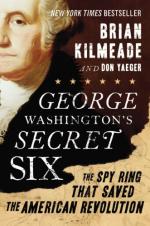|
This section contains 461 words (approx. 2 pages at 400 words per page) |

|
George Washington's Secret Six: The Spy Ring That Saved the American Revolution Summary & Study Guide Description
George Washington's Secret Six: The Spy Ring That Saved the American Revolution Summary & Study Guide includes comprehensive information and analysis to help you understand the book. This study guide contains the following sections:
This detailed literature summary also contains Topics for Discussion on George Washington's Secret Six: The Spy Ring That Saved the American Revolution by Brian Kilmeade.
Long before the days of unmanned drones and Internet hacking, countries still found ways to spy on each other during wartime. George Washington's Secret Six, by Brian Kilmeade and Don Yaeger, tells the little-known story of half a dozen ordinary citizens who quietly conducted espionage for General George Washington to support his goal of retaking New York City from the British.
In the early days of the Revolutionary War, a young patriot named Nathan Hale volunteered to conduct a spy mission on Long Island for the Continental army. He failed miserably and was hanged, but his death left an impression on General George Washington, who commanded the troops. He knew that he needed to outwit the British in order to win the war, especially since his army was outmatched in every way, but he also realized that he needed not just individual spies but a network of them. This was particularly important in the New York area, where British troops had taken Manhattan with its all-important port and economy, as well as Long Island. Washington was desperate to reclaim them.
The spy ring began in 1778 when Washington appointed Benjamin Tallmadge, a major in his army, as the head of his secret service and charged him with recruiting a team. Tallmadge tapped Abraham Woodhull, his Long Island neighbor, as the primary man-on-the-ground, and gave him the code name Samuel Culper. Woodhull proceeded to recruit other Long Island friends including Caleb Brewster, who had an intimate knowledge of the waterways and coastline, Austin Roe, whose tavern was an ideal place for meeting and passing along messages, and Robert Townsend, whose Manhattan store and column in a Loyalist newspaper gave him ample opportunities to gather information without arousing suspicion. The group was rounded out by James Rivington, who owned a coffeehouse and print shop in Manhattan, and a woman known only by the number 355.
Using devices that included a code system, letters written in invisible ink and messages tucked into books, the group began gathering information and using a carefully crafted courier system for passing information from one person to another and finally to Washington in the field. They had a number of successes, including uncovering information in time to thwart a scheme to counterfeit American money, but they also survived many close calls. Washington considered the ring a great help, particularly in misdirecting the British troops as the French navy was arriving to support the Patriots' cause and later in narrowly stopping Benedict Arnold's plan to turn Fort West Point over to the British in exchange for money.
Although Agent 355 apparently perished in a British prison, when the war ended the other five ring members went back to their ordinary lives, never seeking or accepting recognition or reward for their service.
Read more from the Study Guide
|
This section contains 461 words (approx. 2 pages at 400 words per page) |

|



